It was the middle of a cold October night in 2015 when an Israeli army jeep came driving through Aida refugee camp blaring a message through its loudspeaker.
“People of Aida refugee camp, we are the occupation forces,” the message began in Arabic. “If you throw stones, we will hit you with gas until you all die. The children, the youth, the old people – you will all die. We won’t leave any of you alive … Go home or we will gas you until you die. Your families, your children, everyone – we will kill you.”
The Israeli government condemned the message as the act of a single soldier, but Palestinians in Aida, knowing the lethal potential of tear gas, took the threat seriously.
The next day an eight-month-old baby was killed by tear gas inhalation during clashes in a neighboring village.
While Palestinian protesters are generally armed with rocks and a few sporadic Molotov cocktails, Israeli forces are armed with some of the world’s leading crowd control weapons.
Live bullets larger than .22 caliber are the only ammunitions used during clashes that are considered lethal by Israeli standards, but the classifications of tear gas, rubber-coated steel bullets, sponge rounds and .22 caliber live bullets as non-lethal, is, according to medical professionals, misleading.
Mondoweiss spoke with Doctor Nasser al-Jaberi, the Director of the Emergency Room Department at the West Bank’s Arab Society Hospital, to get a better idea of what these weapons are capable of.
“[They] can absolutely kill,” al-Jaberi said. “Rocks are no real threat against an armed military. When you ask if a rock could injure or kill a soldier wearing a helmet, a bullet proof vest, and army-grade clothing, it is hard to imagine, but a protester dying of tear gas inhalation is very common.”
al-Jaberi told Mondoweiss that in certain circumstances nearly every non-lethal weapon used by Israel can, and at some point has, killed.
We asked al-Jaberi to break it down for us, munition-by-munition.
Sponge rounds
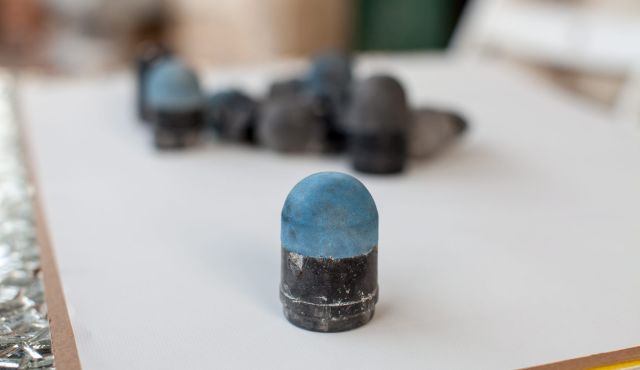
Sponge-tipped bullets. (Photo: Emil Salman via Haaretz)
Sponge rounds, also called sponge grenades or sponge-tipped bullets, are used often by Israeli forces when clashes are happening near Israeli Jewish communities, or when the wind is too strong for tear gas to work well.
At clashes it is easy to tell when Israeli forces are using the rounds.
Youth in the streets are more careful about coming out in the open. They hide behind concrete blocks on the side of the road. In the middle of street wooden boards and other barriers are perched up on light poles and metal dumpsters are pushed out into the road, with youth popping up from behind them just long enough to pop off a rock from their slingshots.
The barriers just get in the way if there is a lot of tear gas being fired and are not sufficient to stop live bullets.
Sponge rounds are designed to be shot over a long distance (the required distance changes depending on the precise version of the ammunition), and only at the lower extremities. When used from a proper distance the harmless-looking rounds cause massive black and blue bruises — when shot at a close distance they can easily stop a heart or crack a skull.
Two types of sponge rounds are used by Israeli forces. The blue-tipped rounds are made up of an aluminum base, plastic base and dense sponge. They can cause serious damage on their own, but in 2015 a new black-tipped sponge round was introduced. The black-tipped rounds are heavier, with more dangerous tips created from synthetic rubber.
“If shot at a very close distance, either sponge round can cause fractures to the skull, which could lead to death,” al-Jaberi said. “They can also be deadly if shot at the chest, eye or neck in some cases. They are certainly less deadly than rubber-coated bullets or tear gas, but that does not mean they cannot cause death or serious injury.”
Sixteen-year-old Muhammad Abdelmajid Sunukrut was shot in the head from around 30 feet away with a sponge round in August 2014. After struggling for a week in the hospital Sunukrut succumbed to his wounds. In July 2016, 10-year-old Muhyee al-Din Tabakhi was hit in the chest with a sponge round, causing internal bleeding that led to the child’s death.
Still, the rounds are considered non-lethal.
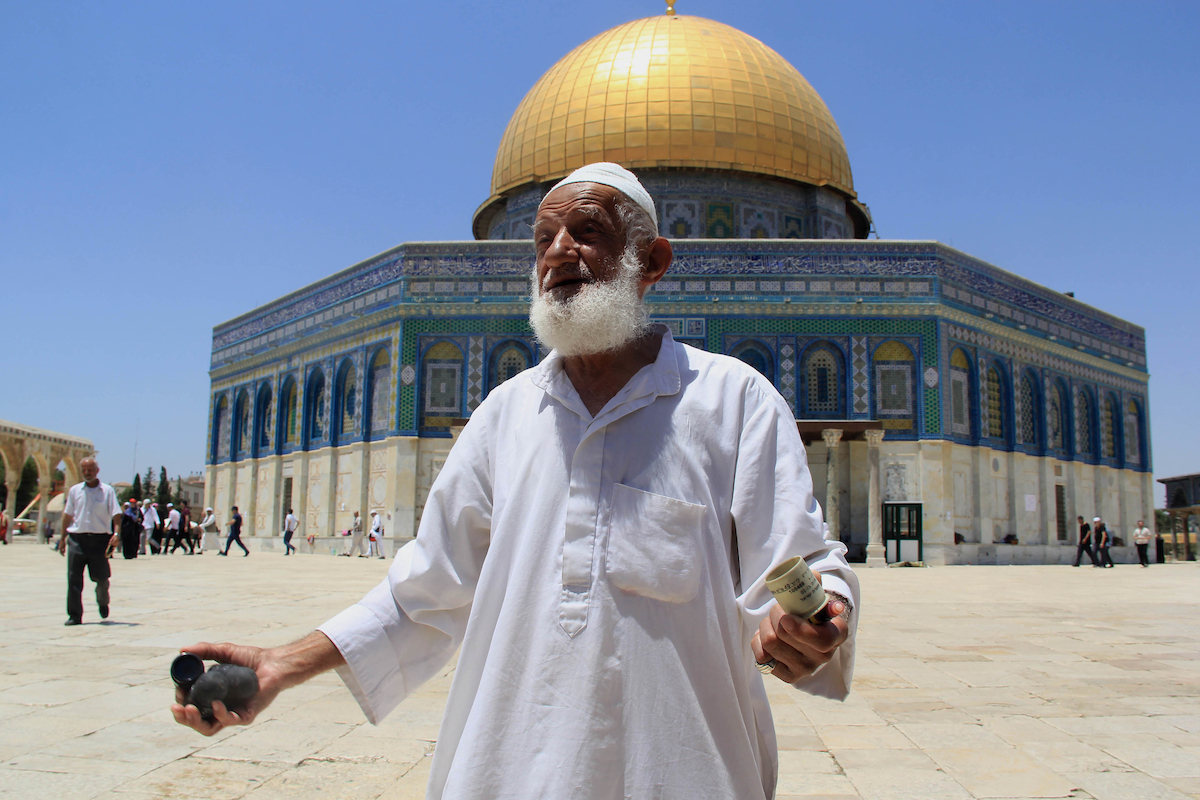
A Palestinian man shows foam-tipped bullets reportedly used by Israeli riot police outside the Dome of the Rock in Jerusalem’s Al-Aqsa mosque compound after clashes erupted at the compound between Palestinians and Israeli police on June 26, 2016 during the holy month of Ramadan. (Photo: Mahfouz Abu Turk/ APA Images)
Rubber-coated steel bullets
Rubber-coated steel bullets are another form of what is, according to al-Jaberi, wrongly considered a non-lethal method of crowd control used by Israeli forces during clashes.
In Arabic sponge rounds and rubber-coated steel bullets go by the same name: “matahta.” While the word and the defense against them (makeshift barriers in the streets) are the same, youth take rubber-coated steel bullets much more seriously when being used in the field by Israeli forces.
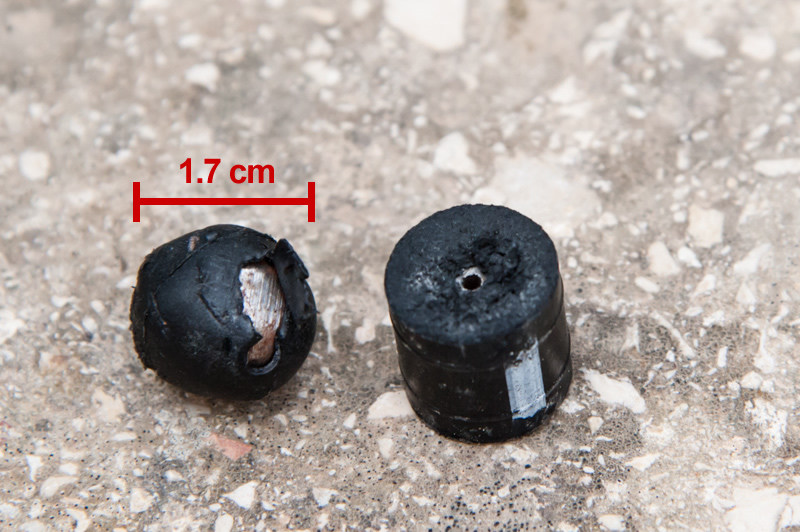
Examples of coated steel bullets used by Israeli forces. One is a steel ball covered in a very thin, hard, material, more like plastic. The other is a softer rubber cylinder shape, but also has a steel core. Both are typically fired from an adapter fitted to the barrel of an M16 assault rifle. (Photo: Ryan Rodrick Beiler)
“A rubber-coated bullet is actually just a metallic bullet covered in a small layer of plastic or rubber, so it is still a bullet,” al-Jaberi said. “We have seen many skull fractures here at the ER from these so-called rubber bullets, and a skull fracture can cause internal bleeding, as well as contusions to the brain. If it is from a close distance in the head, eye, neck or chest these ammunitions have every likelihood of being deadly.”
Al-Jaberi explained that while a real bullet is more likely to make a clean entry and exit, the nature of a rubber-bullet means the entry point is much more likely to be torn open jaggedly, and if shot at a close distance, the bullet more likely to embed itself into the body.
These days Mohammed al-Azza, an award-winning Palestinian photojournalist from the occupied West Bank, never ventures to cover clashes without a bulletproof vest and helmet. In 2013 doctors told the young journalist he could have died if the rubber-coated steel bullet shot at his face while covering clashes had hit him just a centimeter closer to his eye.
He was shot from the second floor balcony, by soldiers positioned on the street just in front of him — much too close to be within protocol of any use of the munition.
The bullet fractured his upper cheek bone. It had to be surgically removed and the journalist has had to undergo multiple other surgeries to reconstruct his face and eye socket. Today there is only a small scar left on his upper cheekbone, but a quarter of his facial skeleton is made up of metal and plastic.
A myriad of other cases documented by rights groups illustrate just how dangerous the ammunition can be, including the 2016 incident in which 12-year-old Mohiyeh al-Tabakhi was shot and killed by Israeli forces after a rubber-coated steel bullet hit the child in the chest, causing him to go into cardiac arrest and die.
Israeli rights group B’Tselem has documented dozens of other Palestinians killed by rubber-coated steel bullets. According to B’Tselem, the Israeli State Attorney’s Office has stated these deaths are “unavoidable mistakes.”
Countless others, like 10-year-old Yahiya al-Amudi, have been shot in the eyes by the ammunition, leaving them partially blinded.
.22 Caliber Bullets
There is no question that a .22 caliber bullet, also known as a tu-tu bullet, is considered live fire — it is — but Israeli forces still consider the ammunition a “non-lethal” crowd control method.
The small bullets are less powerful than larger cartridges, but they carry a deadly punch, just like any other bullet, particularly when the .22 calibers are hollow-tip bullets, also known as expanding, dum-dum, exploding or fragmented bullets.
According to al-Jaberi, the majority of the bullet wounds he treats are from these types of expanding bullets — the use of which is considered a war crime under international law.
“Most of the bullet wounds we treat here contain fragmented bullets. When they enter the skin they explode into many fragments. If this reaches the bones we call it comminuted fractures,” he said, explaining that these kind of fractures mean the bone was hit at high velocity and fractured into more than two pieces. “We have had some of these cases where the bullet fragments sliced arteries and that is a very serious injury that could definitely kill in certain circumstances.”
In 1981 John Hinckley Jr. shot then-U.S. President Ronald Reagan with a .22 caliber loaded with expanding bullets. While Reagan spent two weeks in the hospital recovering, the former president’s White House Press Secretary James Brady was shot in the head and suffered permanent brain damage that left him partially paralyzed and confined to a wheelchair for the rest of his life.
Israeli authorities deny the use of expanding bullets in their arsenal.
After the first year of the Second Palestinian Intifada, the head of the security department in the Operations Directorate of the Israeli military announced that the .22 bullet was too deadly to use as a form of crowd control and discontinued its use between the years of 2001 and 2008, according to B’Tselem.
The .22’s were eventually brought back into use, and by 2015 B’Tselem found that there was “a steady erosion in the restrictions on firing… leading to ever greater use of this weapon,” which it said was “misleadingly portrayed as a non-lethal measure.”
“The indisputable facts are that we are dealing with a lethal weapon, which the Israeli authorities falsely present as a reasonable tool to employ in dealing with demonstrations,” the report added.
In the first ten months of 2015, four Palestinians were shot and killed by .22 calibers, including 13-year-old Abdelrahman Obeidallah, who was shot with a .22 caliber bullet straight to the heart right after school let out.
Israeli forces said the shooter had not breached protocol in using the .22 as a non-lethal munition at the time of the 13-year-old’s death. According to Israeli officials, the soldier was shooting for the legs of another youth, when the bullet ricocheted up and hit Abdelrahman, showing that even when used according to Israel’s protocol, the bullets can be deadly.
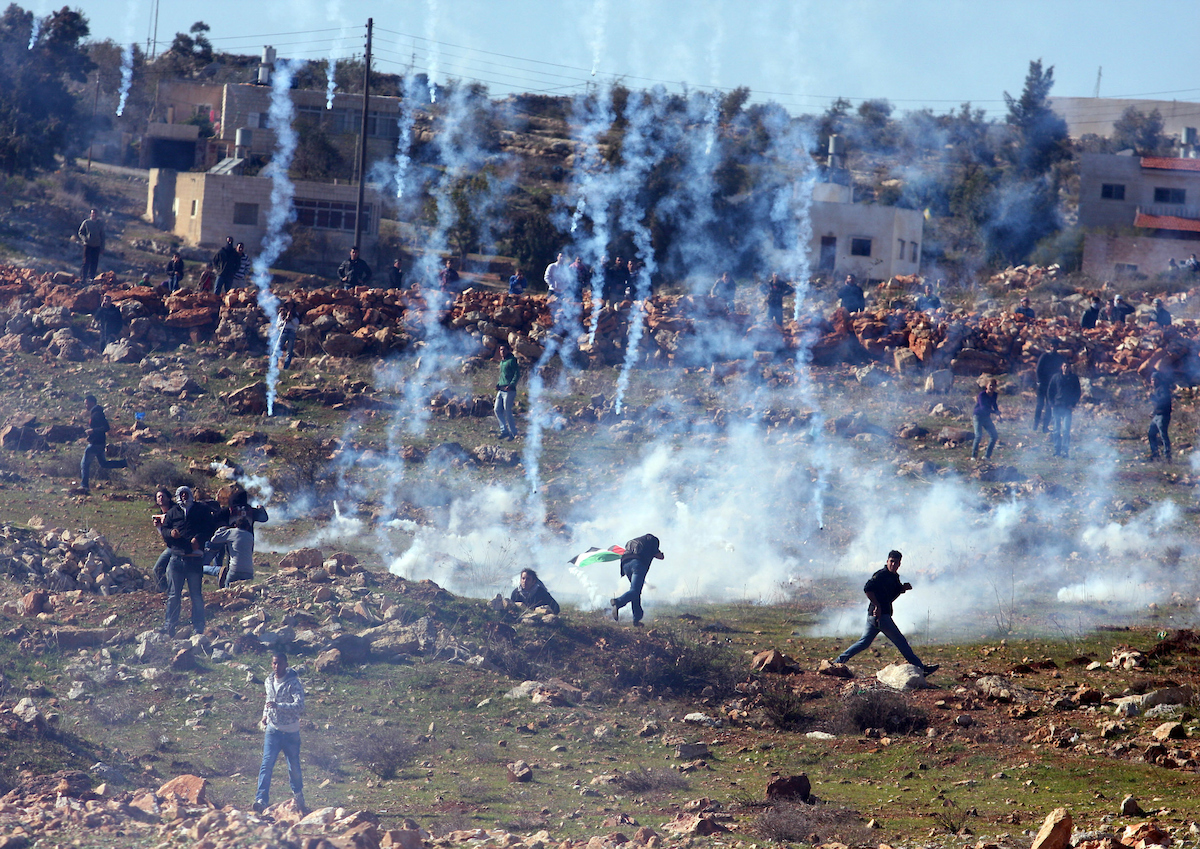
Palestinians try to avoid tear gas fired by Israeli soldiers during clashes which erupted after the funeral of Palestinian Mustafa Tamimi in the West Bank town of Nabi Saleh, Sunday, Dec. 11, 2011. (Photo: Issam Rimawi/APA Images)
Tear gas
More than 1,000 Palestinians were injured during the two weeks of daily clashes that followed the al-Aqsa mosque crisis last month, according to the Red Crescent. Most of those injuries were caused by severe tear gas inhalation.
Tear gas is actually not a gas at all, it is a powder mixed with a liquid substance that when released as an arsenal, resembles gaseous clouds. It also affects much more than just the eyes and tear ducts. Tear gas works by irritating mucous membranes in the eyes, nose, mouth and lungs. Touching your face, eyes, or trying to use water to wash it off only intensifies the symptoms.
The fact that it is a solid means the “gas” eventually settles on surfaces around the area it was administered. In the occupied West Bank, some areas are tear gassed nearly daily, meaning surfaces like balconies and window ledges, for instance can become caked in the substance. If someone unknowingly touches a railing, then wipes their face or other sensitive areas of the skin, the concentrated powder causes chemical burns.
“I have had many patients come in with serious respiratory distress from tear gas,” al-Jaberi said. “In particular circumstances tear gas can easily kill someone — for example if someone has a pre-existing condition, or if the patient is a small child, a very old person, and even in some cases, healthy people.”
Earlier this year 18-month-old Abdelrahman Barghouti died from asphyxiation after tear gas was shot by Israeli forces into the child’s family home.
Al-Jaberi’s most recent serious patient suffering from tear gas exposure had to be hospitalized for a week before being released because of respiratory damage triggered by the gas.
Even among healthy individuals, concentrated exposure to tear gas causes sharp pain in the chest and the sensation of suffocation.
Palestinian doctors, medics and nurses, as well as the general populace, know very well how to deal with the immediate effects of tear gas exposure, but al-Jaberi is concerned with the unknown effects it could trigger over time.
“I can’t give any specific evidence on the long term effects of the gas until there are serious research studies done about it,” he said. “Unfortunately there have not been many studies on the case, but we should be monitoring the people who are exposed to this gas on a daily basis, like those who live in the refugee camps, because I think it is logical to say that these people would have a much higher likelihood of having serious respiratory problems when compared to people not frequently exposed to the gas. We can feel certain there are side effects, but without studies it is hard to say for sure.”
Tear gas canisters
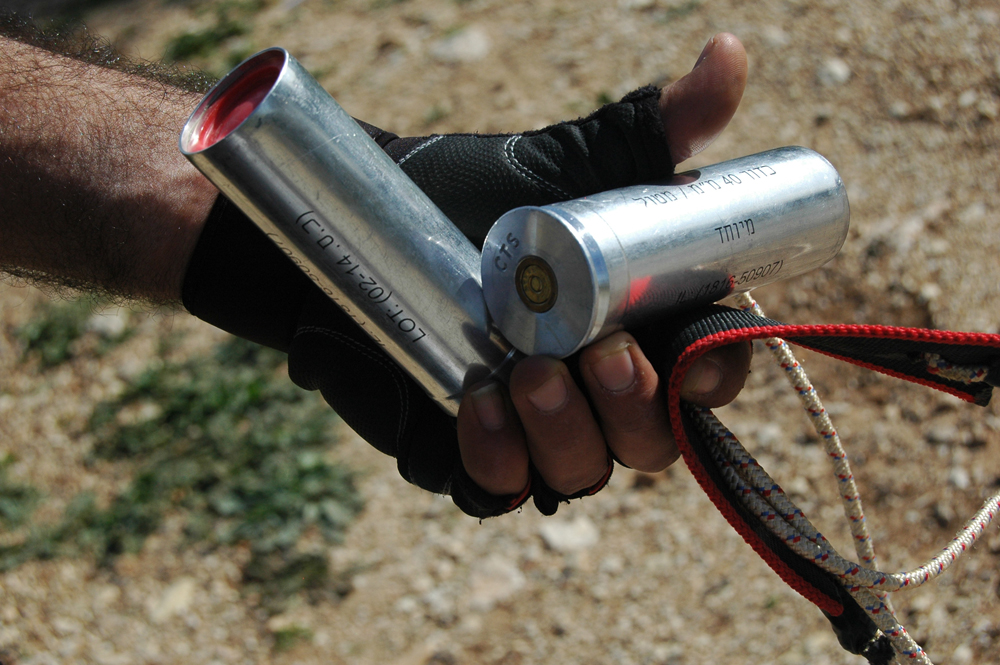
Tear gas canisters collected at the end of Bil’in’s tenth anniversary protest, February 27, 2015. (Photo: Allison Deger)
In addition to the gas itself, the canisters used to administer tear gas are shot at high velocity and can do serious damage if the canister hits vulnerable parts of the body.
“I’ve had many patients injured from the canisters. One of my patients was hit in the head with a gas canister at short range and it caused a fracture to the skull and damage to the bone around the eye,” al-Jaberi said.
The cases of tear gas killing, both from the gas itself and direct contact from the canisters, is well documented.
While Israeli military regulations prohibit firing tear gas directly at people, B’Tselem has extensively documented cases of the practice.
In March 2009 U.S. citizen Tristan Anderson was shot in the head with a tear gas canister and to this day suffers from severe brain damage. A month later, Bassem Abu-Rahmah, from the village of Bil’in, was hit in the chest by a tear gas canister and killed. Bassem’s death was made famous after his killing was featured in the Oscar-nominated film Five Broken Cameras.
The death of Bassem, a beloved and well-known Palestinian activist, was covered by media internationally, but it did not help to mitigate Israel’s use of tear gas against Palestinian protesters.
Two years after Bassem was killed, his sister died due to respiratory failure caused by tear gas inhalation. Eleven months after that Mustafa Tamimi was killed after being hit with a tear gas canister during clashes in Nabi Saleh.
Israeli forces closed both Abu-Rahmah’s and Tamimi’s case files without indictment. B’Tselem condemned the decision, stating that it gave “Israeli soldiers and officers the unequivocal message that, should they kill unarmed civilians, they will not be held accountable.”
“Given this state of affairs, it is hardly surprising that soldiers and Border Police officers continue to shoot tear-gas canisters directly at Palestinians, endangering their lives. Under such circumstances, it is only a matter of time before yet another unarmed Palestinian civilian is killed in this way,” the group said in a 2013 report.
Four years later, injuries and deaths caused by direct contact with tear gas canisters are still common occurrences.
Source Article from http://mondoweiss.net/2017/08/bullets-israels-munitions/
Related posts:
Views: 0
 RSS Feed
RSS Feed

















 August 15th, 2017
August 15th, 2017  Awake Goy
Awake Goy 



 Posted in
Posted in  Tags:
Tags: 
















